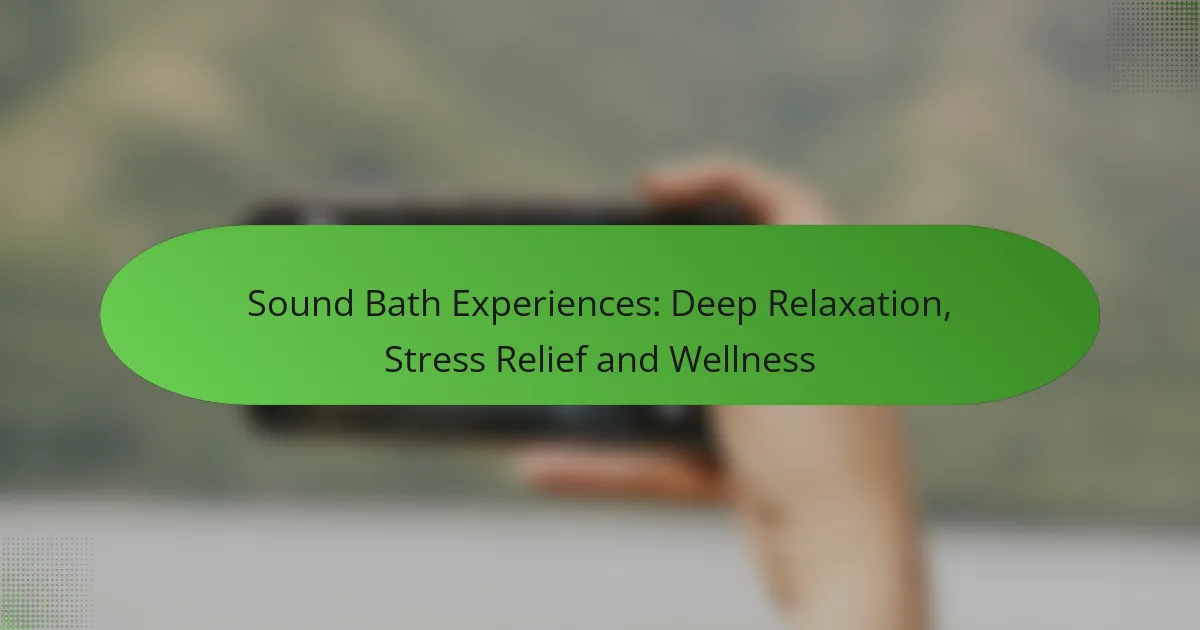Sound bath experiences provide a unique opportunity for deep relaxation and stress relief through the use of resonant sounds that induce a meditative state. By harnessing sound frequencies and vibrations, participants can release tension and anxiety, fostering a profound sense of calm and well-being. These sessions are available in various venues, including wellness centers and yoga studios, making it accessible for anyone seeking to enhance their wellness journey.

How Do Sound Bath Experiences Promote Deep Relaxation?
Sound bath experiences promote deep relaxation by using resonant sounds to induce a meditative state. This practice helps to calm the mind and body, allowing participants to release tension and stress.
Vibrational therapy
Vibrational therapy is a core component of sound baths, utilizing sound waves to create vibrations that resonate within the body. These vibrations can help to align energy centers, or chakras, promoting physical and emotional healing. Participants often report feeling a sense of balance and harmony after a session.
In a typical sound bath, instruments like singing bowls, gongs, and tuning forks are used to produce a range of frequencies. Each frequency can target different areas of the body, enhancing the therapeutic effects.
Enhanced mindfulness
Sound baths encourage enhanced mindfulness by providing a focused auditory experience that draws attention away from daily distractions. The immersive sounds create an environment conducive to meditation, allowing participants to connect with their inner selves. This heightened state of awareness can lead to greater clarity and presence in everyday life.
Practicing mindfulness during a sound bath can involve simply listening to the sounds and observing thoughts without judgment. This practice can help cultivate a deeper sense of peace and relaxation.
Reduction of anxiety
Sound baths can significantly reduce anxiety levels by promoting relaxation and a sense of safety. The soothing sounds help lower cortisol levels, which are often elevated during stressful situations. Many participants find that regular attendance at sound baths can lead to long-term improvements in their anxiety management.
Incorporating sound baths into a wellness routine may complement other anxiety-reducing practices, such as yoga or meditation, creating a holistic approach to mental health.
Improved sleep quality
Improved sleep quality is another benefit of sound bath experiences, as the calming effects of sound can help ease the mind before bedtime. Participants often report falling asleep more easily and experiencing deeper, more restorative sleep after a session. This can be particularly beneficial for those struggling with insomnia or restless nights.
To maximize the sleep benefits, consider attending sound baths in the evening or incorporating sound therapy at home with recordings of soothing sounds before bedtime.
Emotional release
Emotional release is a common outcome of sound bath experiences, as the deep relaxation can unlock pent-up emotions. The vibrations and sounds can facilitate a cathartic experience, allowing individuals to process feelings they may have been holding onto. This release can lead to a sense of relief and emotional clarity.
Participants are encouraged to approach sound baths with an open mind, allowing themselves to feel and express emotions that arise during the session. This process can be transformative and contribute to overall emotional well-being.

What Are the Benefits of Sound Baths for Stress Relief?
Sound baths offer various benefits for stress relief, primarily by promoting relaxation and reducing anxiety. Through the use of sound frequencies and vibrations, participants often experience a profound sense of calm and well-being.
Lower cortisol levels
Sound baths can significantly lower cortisol levels, which is the hormone associated with stress. Research suggests that engaging in sound therapy may reduce cortisol by up to 30%, helping to alleviate feelings of tension and anxiety.
To maximize this benefit, consider participating in regular sound bath sessions, ideally once a week. Consistency can lead to more sustained reductions in stress hormone levels.
Increased serotonin production
Participating in sound baths can enhance serotonin production, a neurotransmitter that contributes to feelings of happiness and well-being. The soothing sounds and vibrations help stimulate the brain’s release of serotonin, promoting a more positive mood.
For those seeking to boost their mood, incorporating sound baths into a wellness routine can be an effective strategy. Aim for sessions that last at least 45 minutes to fully experience the mood-enhancing effects.
Physical tension release
Sound baths are effective in releasing physical tension stored in the body. The vibrations from instruments like singing bowls and gongs can penetrate muscle tissue, leading to relaxation and relief from tightness.
To enhance this benefit, focus on your breath during the session. Deep breathing can further facilitate the release of tension, allowing for a more comprehensive relaxation experience.
Enhanced mental clarity
Many participants report improved mental clarity following sound baths. The meditative state induced by sound therapy can help clear mental fog, leading to better focus and cognitive function.
To achieve this clarity, consider integrating sound baths into your routine before engaging in tasks that require concentration. This can help set a calm and focused mindset for the day ahead.

Where Can You Find Sound Bath Experiences in Your Location?
Sound bath experiences can be found in various venues across your location, including wellness centers, yoga studios, and spas. These places often offer sessions designed to promote relaxation and stress relief through sound therapy.
Local wellness centers
Wellness centers are dedicated spaces that focus on holistic health and often provide sound bath experiences as part of their offerings. Look for centers that feature certified practitioners who can guide you through the session, ensuring a safe and effective experience.
When selecting a wellness center, consider their reputation and customer reviews. Many centers offer introductory sessions at a lower cost, allowing you to try a sound bath without a significant financial commitment.
Yoga studios
Many yoga studios incorporate sound baths into their class schedules, often as a way to enhance relaxation after a physical practice. These sessions typically involve lying down while sound waves from instruments like singing bowls fill the space, promoting deep relaxation.
Check the class schedule for special sound bath events, which may be held monthly or seasonally. Some studios offer packages that combine yoga classes with sound therapy, providing a comprehensive wellness experience.
Spas offering sound therapy
Spas that focus on wellness often include sound therapy as part of their treatment menu. These sound baths may be offered as standalone services or combined with massages and other treatments to enhance relaxation and stress relief.
Inquire about the qualifications of the therapists providing sound therapy, as well as the types of instruments used. Many spas have tranquil environments designed to maximize the benefits of sound therapy, making it a worthwhile addition to your self-care routine.

What Should You Expect During a Sound Bath Session?
During a sound bath session, participants can expect a deeply immersive experience designed to promote relaxation and stress relief. The session typically involves lying down while various instruments create soothing sounds that facilitate a meditative state.
Duration of the session
Sound bath sessions usually last between 45 minutes to 90 minutes, depending on the facilitator and the specific format of the experience. A typical session may start with a brief introduction followed by the sound immersion itself.
It’s advisable to arrive a few minutes early to settle in and prepare for the experience. Some practitioners may offer shorter sessions for beginners or those with time constraints.
Types of instruments used
Common instruments in sound baths include singing bowls, gongs, chimes, and tuning forks. Each instrument produces unique frequencies that can resonate with different parts of the body, enhancing relaxation and emotional release.
Facilitators may choose specific instruments based on the intended therapeutic effects, such as using crystal bowls for clarity or gongs for deeper vibrations. The combination of sounds creates a rich auditory environment that aids in stress relief.
Guided meditation elements
Many sound bath sessions incorporate guided meditation elements, where the facilitator may lead participants through visualization exercises or breathing techniques. This guidance helps deepen the relaxation experience and encourages mindfulness.
Participants are often encouraged to focus on their breath and let go of distractions, enhancing the overall benefits of the sound therapy. This combination of sound and meditation can significantly improve mental clarity and emotional well-being.

How to Choose the Right Sound Bath Experience?
Selecting the right sound bath experience involves considering the instructor’s qualifications, the types of sound therapy offered, and your personal preferences. Understanding these factors can enhance your relaxation and wellness journey.
Instructor qualifications
When choosing a sound bath, it’s essential to evaluate the instructor’s qualifications. Look for certifications in sound therapy, holistic health, or related fields, as these indicate a level of expertise and professionalism.
Experience is also crucial; instructors with several years of practice may offer deeper insights and more effective sessions. Don’t hesitate to ask about their background and training to ensure you feel comfortable and safe during the experience.
Types of sound therapy offered
Sound baths can vary significantly in the types of therapy provided. Common modalities include crystal singing bowls, Tibetan bowls, gongs, and tuning forks, each producing unique vibrations that can affect the body and mind differently.
Consider what resonates with you personally. For example, if you prefer gentle tones, crystal bowls may be ideal, while those seeking a more powerful experience might opt for gongs. Researching the specific benefits of each type can help you make a more informed choice.



